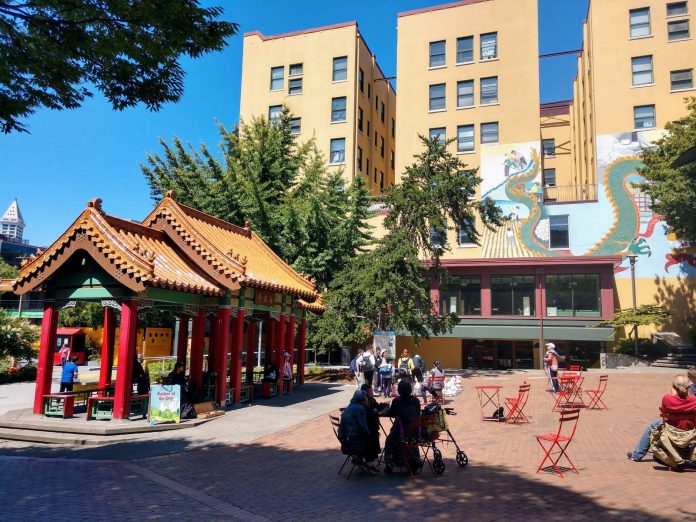
According to news reports, it is difficult to walk into Chinatown without seeing urban blight and homelessness. The city’s pre-eminent ethnic neighborhood is difficult to navigate without stumbling over drug debris and tents. Videos of people sleeping unsheltered and photos of litter in the curbs are interspersed with concern editorials about the impact of turmoil on elders and tourism. Officials are elected to be tough on crime.
Unfortunately, it’s not clear which Cascadian city we’re talking about. That “Chinatown Ruined” commentary has been made in Portland, Seattle, and Vancouver, BC. All three have large traditional Chinatowns that have been the focus of increased crime and the speculation that goes along with it. Too-liberal policies and decriminalization of misbehavior have drawn the ire of opinion writers looking for targets to blame. Trite assumptions morph into racist stereotypes and hate crimes.
In some ways, the Chinatowns have outgrown the cities. With 465,000 King County residents claiming heritage from many different parts of Asia, neither the space or the blanket term “Chinatown” can cover them all. Neighborhoods and very good restaurants headed north along SR99 or out towards Redmond are testament to new generations decamping to the suburbs. The same can be said for Richmond outside of Vancouver and the Jade District in Southeast Portland. Frankly, the more we say about the dim sum in Richmond, the less we can eat. That’s just tragic.
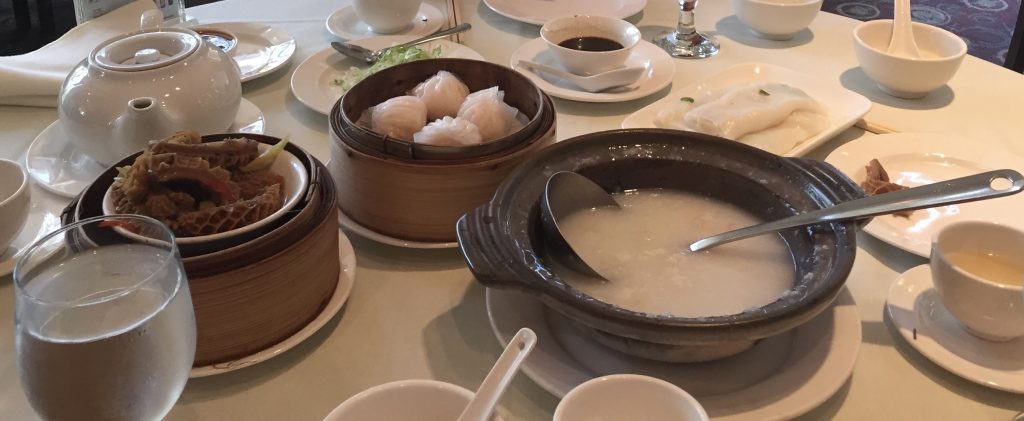
But the close-in, traditional Chinatowns are the consistent focus of media coverage about crime, homelessness, and drug use. Given the very general nature of the complaints and the very different specifics of crime rates and drug policy in each city, perhaps it is time to consider how the traditional Chinatowns are experiencing similar trends for other reasons. Not based on ethnicity, but on the very similar structural issues that formed them and kept them as enclaves.
These are the continent’s oldest Chinatowns located in very young Pacific Northwest cities. They are facing problems because they do not succumb to the same fast, disposable expansion the metro areas have become accustomed. If the cities stop throwing the same nonsensical ideas around, Cascadia’s Chinatowns offer the cities lessons in neighborhood preservation and the failure of trying to bulldoze one’s way into the future.
Enclave Encircled
Structurally, Cascadian Chinatowns are remarkably similar. Due to their age, they are appendages of the oldest part of each city. At the same time, each is curtailed by highway and transit infrastructure.
Chinatown in Portland is unfortunately the least cohesive of the three and the only one between the downtown and the city’s waterway, sandwiched north of downtown and east of the Pearl District against the rail and surface highways that run along the Willamette River. Combined with the historic Old Town neighborhood, there are 3,600 residents. The city’s One Point of Contact campsite report showed almost 50 campsites in the neighborhood, where the city has engaged in sweeps.
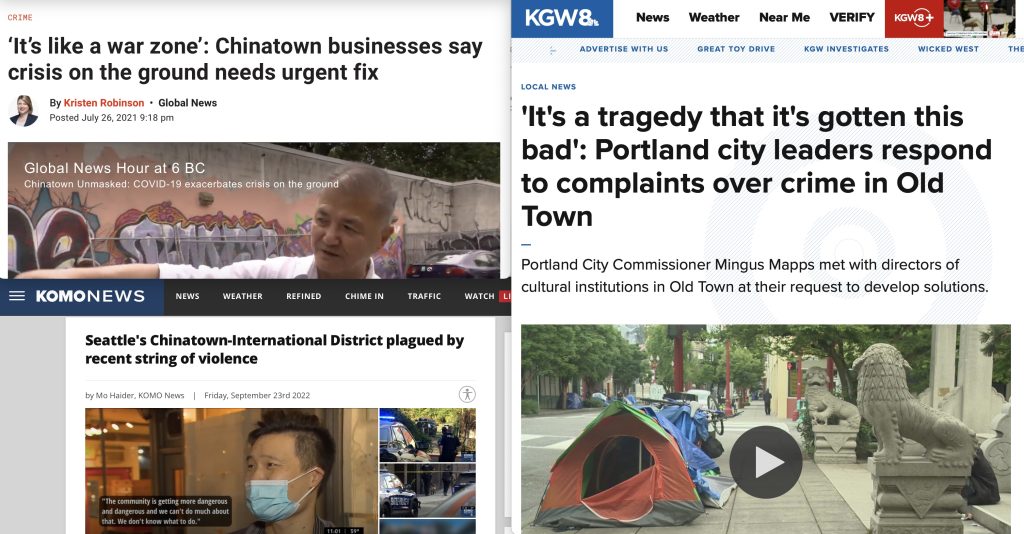
In Seattle, the Chinatown-International District is up the hill from Elliott Bay and the historic Pioneer Square, separated by rail and the wide 4th Avenue corridor. It is the consolidation of Chinatown, Japantown, and Little Saigon, which are roughly separated by I-5 and Jackson Streets. The community of 4,600 is 43% Asian, 20% Black, and 27% White. The city’s absolutely garbage homelessness dashboard consolidates all the Downtown Neighborhoods together, showing 168 campsites were closed across downtown through September 2022. Clusters are apparent in the CID.
In Vancouver, rail runs along the south side of Burrard Inlet, with the historic Gastown adjacent, then Chinatown to the south. The neighborhood extends around Andy Livingstone Park to the Georgia and Dunsmir Viaducts marking the southern neighborhood boundary. There are between 1,500 and 24,000 residents of Chinatown, depending who is counting. Five of the city’s 18 shelters are located within two blocks of the neighborhood.
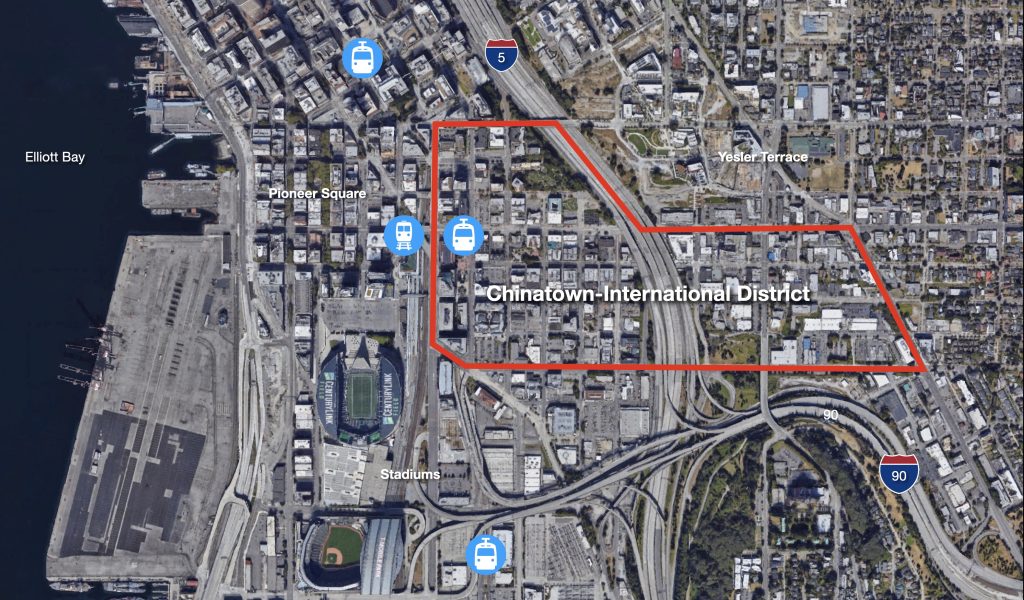
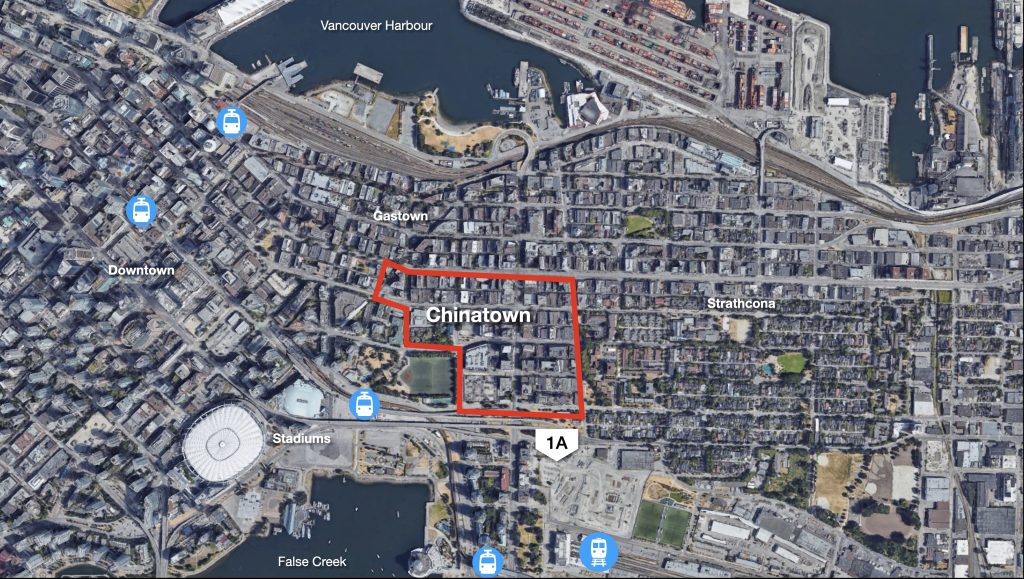
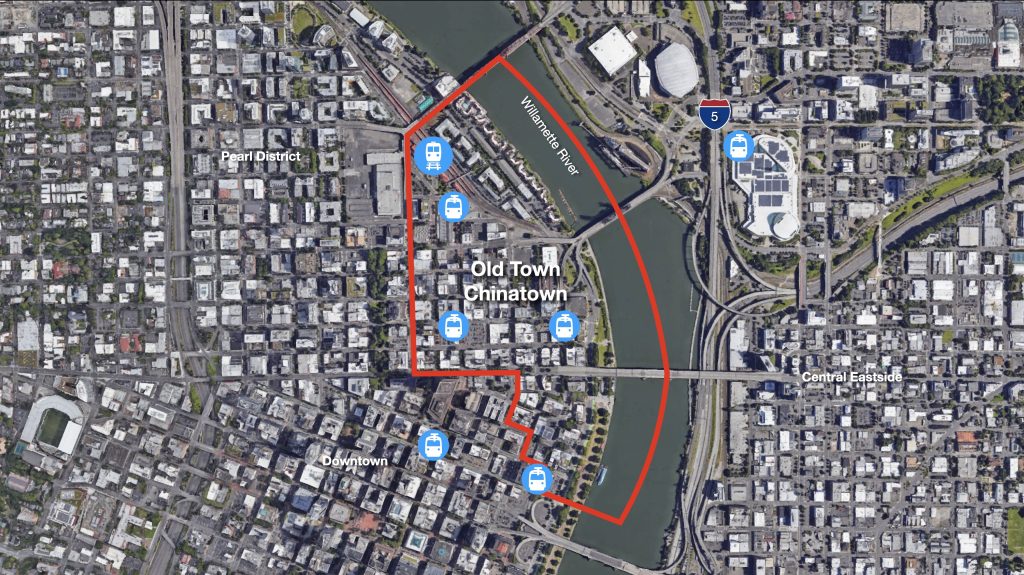
Highways present significant barriers to each of the enclaves. Portland’s Chinatown receives ramps and traffic from the Steel Bridge, Burnside Bridge, and Broadway Bridge, as well as being bounded by the broad Naito Parkway and Burnside Street. Vancouver’s Chinatown is bordered to the south by the Dunsmir Viaduct and Georgia Viaduct, just as they lift off from surface highways to wrap around Rodgers Arena and into downtown. Seattle, of course, went above and beyond by driving Interstate 5 through the heart of the district.
With cars comes parking. An entire block of 4th Avenue between Couch Street and Davis Street in Portland is a surface parking lot. If you can’t get into the surface parking in Seattle’s King Street lot, Uwajimaya around the corner validates for its 100 spaces. Vancouver’s city-owned Chinatown Plaza hosts some ground floor retail under four stories and 930 parking spaces.
The oddity is that, for each of these neighborhoods, transit is not lacking. Due to their proximity to downtown, each city’s Chinatown is a hub of buses and fixed transit. The stops are just designed to move a lot of people through. Portland’s Max light rail has four stops in the district, three as the Yellow and Green lines serve the train station; one on the Blue and Red lines before those tracks head out of town. Vancouver’s Chinatown is served by a Rapidbus stop just before the downtown loop, and one Sky Train stop that it shares with the Stadiums. Seattle’s CID Link stop is a current point of contention as plans to expand it for new lines will either tear up 4th Avenue for a decade or bury a station in the center of the Earth. Alternatives on 5th Avenue have been pulled out for being too disruptive to Chinatown businesses.
All three enclaves are designated Historic Districts and zoned for mixed downtown commercial uses. In Vancouver, that includes specific bylaws designating historic zoning that allow for ground floor retail and mixed residential uses in 5- and 6-story buildings. For Portland, the district is on the National Register of Historic Places and covers an area that is zoned Central Commercial like much of the downtown to the south. Seattle’s CID is also on the National Register and zoned IDM, a downtown mixed use designation, but is capped between 75 and 85 foot heights in the neighborhood.
But it’s those zoning maps that really drive home a point. These neighborhoods are the fringe of downtown just before a massive industrial district. Portland’s industry is on the other side of the Willamette. Seattle’s is on the other side of the stadiums. Vancouver has the Strathconia community between. But the Chinatowns are pinched between some of the priciest of downtown real estate and commercial towers, and the edge of highways, rail, and warehouses.
There is a good case to be made that, if the Chinatowns in Cascadia were not protected and cohesive ethnic enclaves, they would be swallowed up by one or the other of these two sides. There’s another argument that suggests it’s already happening with gentrification. The roles of workers in these neighborhoods defined a good amount of their built form. The Chinatowns have a history of worker housing and single room occupancy (SRO) buildings due to itinerate workers and single males immigrating ahead of larger families. Such buildings are targets for conversion to luxury apartments.
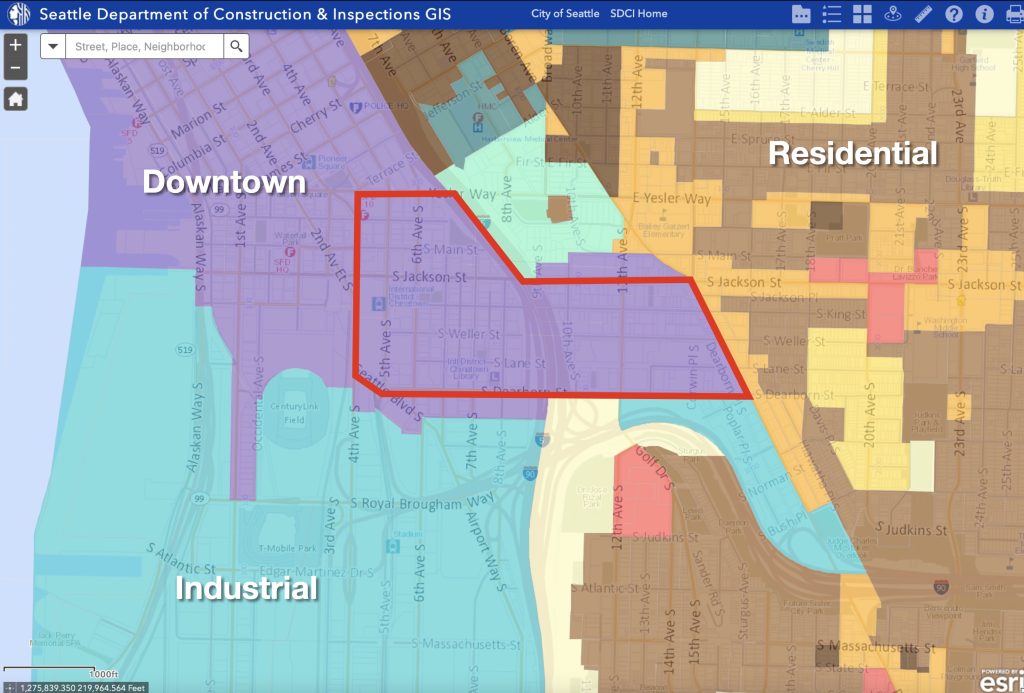
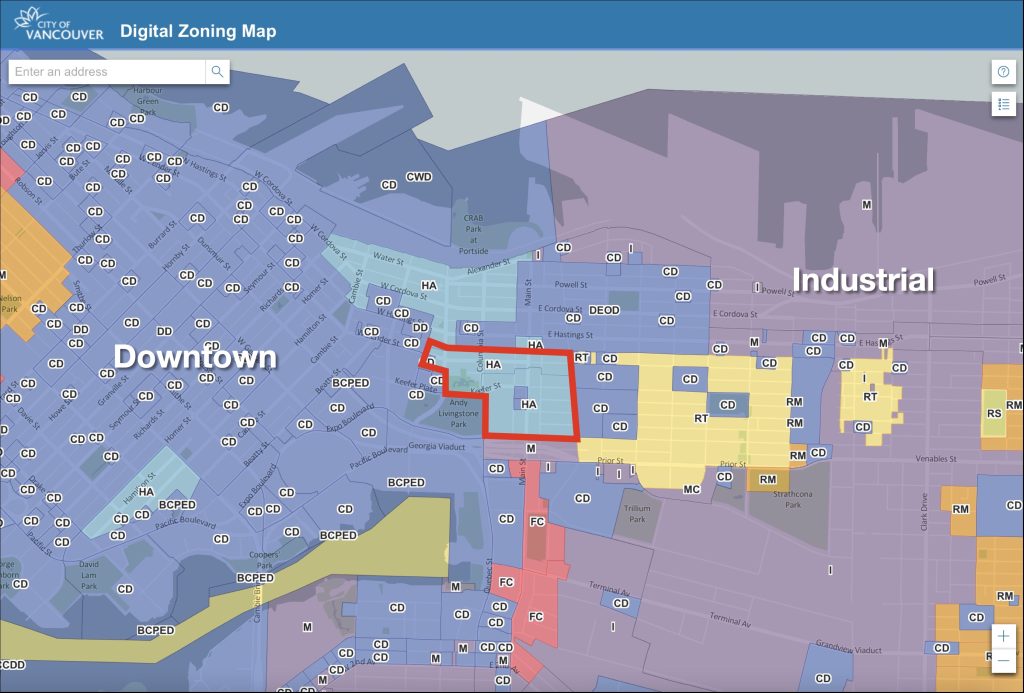
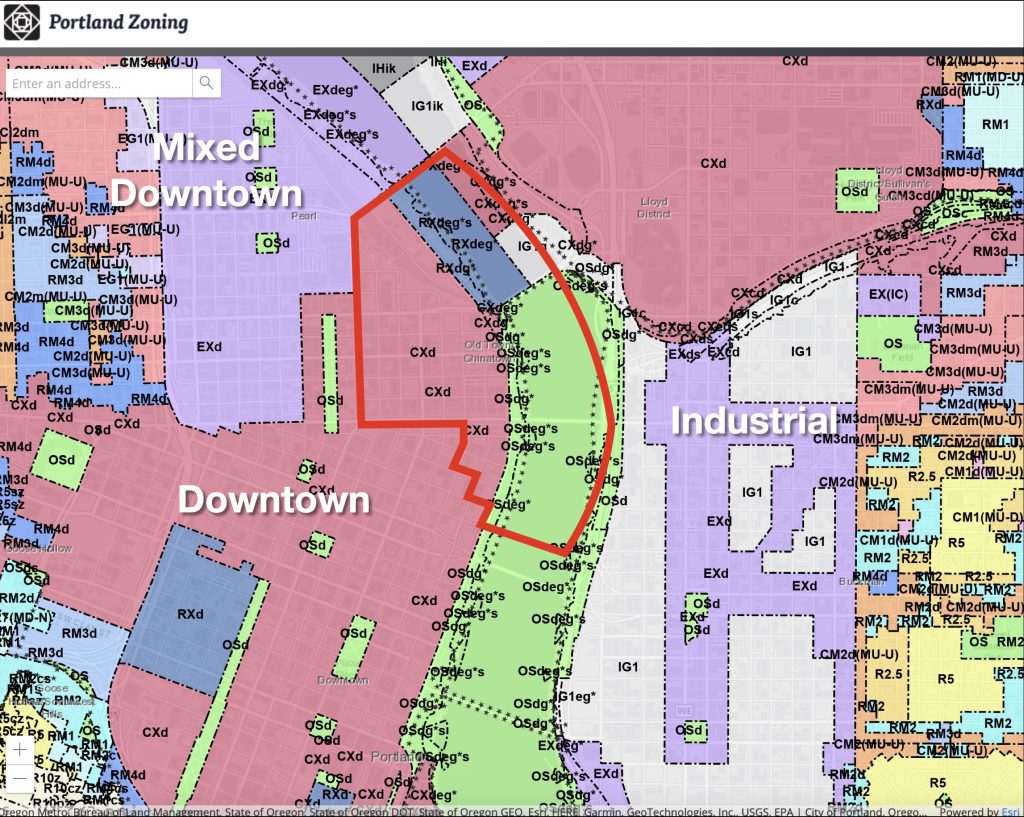
Enclave Ethnic
And that’s where it stops being possible to separate the Chinatown enclaves from the fact they formed around an ethnicity. Even that is trite, as most of these places were an amalgam of cultures from Southeast Asia and China, but consolidated through other-ness, and left to fight other non-White groups for space at the edge of town. The SROs formed because Chinese immigrant men had no where else to stay as they were building the continent’s infrastructure.
In all three cities, Chinese enclaves date concurrently to the municipality itself. Many immigrants from China found themselves in Cascadia during gold rushes of the 1850’s and stayed through the end of the century railroad boom. Portland claims the nation’s second oldest Chinatown (after San Francisco), founded in the early 1850’s when the city itself was founded in 1851. In 1880, Vancouver boasted 99% of Canada’s total Chinese population of 4,400 people. The city itself was incorporated in 1886. Seattle’s first Chinatown was near the waterfront Yesler Mill, from which Chinese immigrants were driven out of the town of Seattle in 1886, three years before incorporation as a city.
From there, the history of anti-Asian sentiments and fortification of an enclave run very parallel between the cities. Seattle’s Chinese residents faced racism progressively expelling them from the city’s expanding boundaries. Canada passed a $50 per person head tax to prohibit immigration in 1885, increasing it to $500 by the turn of the century. Portland received many Chinese workers who were driven out of other towns in Oregon, but blamed them for everything from job loss to prostitution. Each city saw riots as white laborers threatened and assaulted Chinese immigrants under the guise of reclaiming work.
Both countries incarcerated and forcibly relocated West Coast Japanese-descended families during World War II. Both countries identified poorer neighborhoods for demolition and highway construction in the 1960’s, in an effort to move cars in and out of downtown.
These communities have existed for the entire lifespan of the cities they are a part apart. The cities’ histories are irrevocably linked to their treatment of the Chinese and Asian immigrants. Unlike East Coast cities that had three or five generations of immigrant assimilation and governance before the 1850’s, Chinatowns have always been in Cascadian cities. It is a unique relationship to any on the continent. Even San Francisco existed as a city for a century before the first groups of Chinese immigrants settled in town.
Enclave Immovable
In cities that have spent their entire century-and-a-half existence as fast growing, boundary shoving growth machines, the line between Cascadia’s downtowns and Chinatowns has been slow to move. The cities are used to pushing unwanted uses to the fringe. That’s what put these enclaves where they are in the first place.
The boundary around the ever-present Chinatowns is itself difficult for the cities to understand. Pushing development up to the edge of Chinatown imposes a lot on the enclave, while pulling back fails to maximize development downtown. In the end, the cities’ reticence allows the line to become its own fringe and fills with uses unwanted by elites, like homeless shelters and transit hubs. Which brings us back to the threats on the Chinatowns.

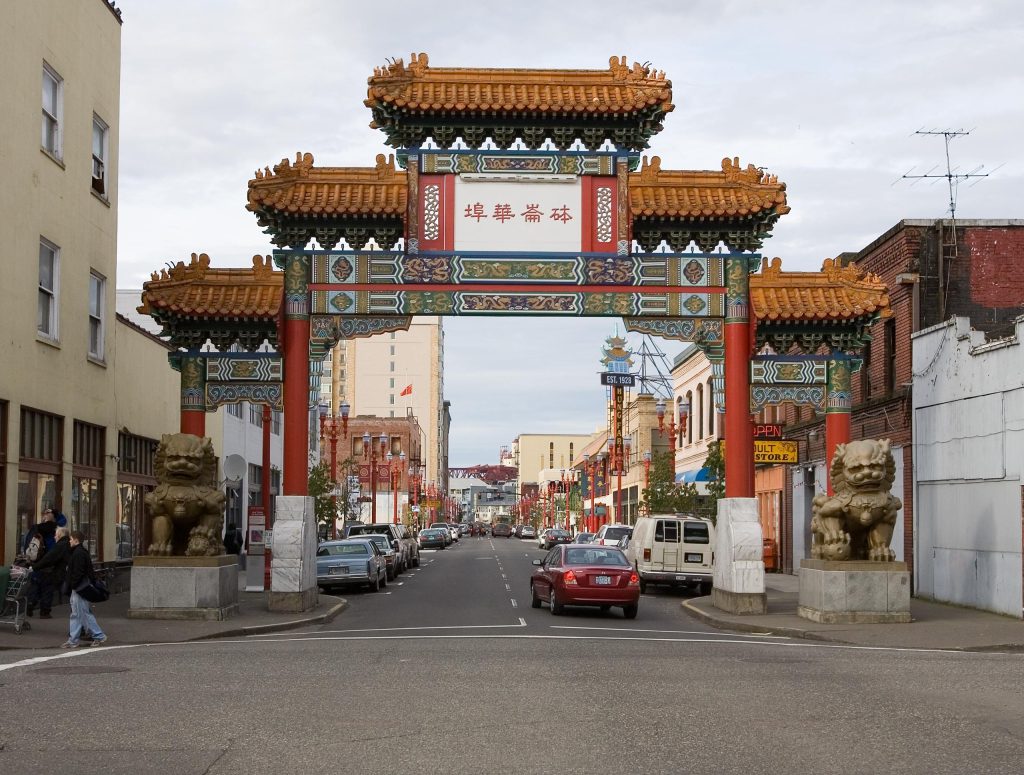

In reality, the Chinatowns’ consistency is a contrast to the boom and bust of the central business districts. When the corporate towers are flying high, the enclaves look like bargains for gentrification. When downtown’s business is slow, Chinatown looks healthy and vibrant and ready for assimilation. When offices are empty due to Covid, the residential neighborhood attracts attention from people who have nowhere else to go.
These neighborhoods are great places because they are historic, and residential, and actively changing. Take any of those out of the equation, and you end up with shiny vapid tower, desolate office park, or boring suburb. Increase the rate of actively changing, and that would allow for the wholesale demolition and construction that occurs in much of the city.
Chinatowns in Portland, Seattle, and Vancouver have a lot to teach us. Not because of some ridiculous (and kinda racist) trope about ancient Eastern wisdom. The lesson is how hard Cascadia’s cities are struggling to not bulldoze a problem out of existence. Our very young cities have not yet figured out how to rely on ourselves to address current urban problems. We have taken rules like historic districts from much older East Coast cities and dropped them onto places expecting some city magic to happen. It hasn’t. It won’t. City magic is the hard work of countless people, building and caring for places we grow to love. Like the region’s Chinatowns, in spite of it all.
Ray Dubicki is a stay-at-home dad and parent-on-call for taking care of general school and neighborhood tasks around Ballard. This lets him see how urbanism works (or doesn’t) during the hours most people are locked in their office. He is an attorney and urbanist by training, with soup-to-nuts planning experience from code enforcement to university development to writing zoning ordinances. He enjoys using PowerPoint, but only because it’s no longer a weekly obligation.


